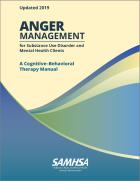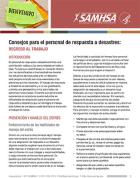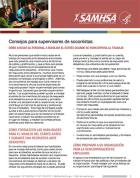This brochure features the national Disaster Distress Helpline, which supports people who are coping with the after effects of a disaster. Learn about a disasters’ potential to cause psychological stress, warning signs of distress, and tips for coping.
Dashboard: Filter Bricks
Main page content

This updated manual contains a 12-week cognitive–behavioral anger management group treatment model. The content includes specific instructions and suggested remarks for group leaders, and exercises for group members. This model will work in a variety of clinical settings, and with diverse audiences.

This report gives an overview of suicide prevention strategies used in Alaska. It provides background information on the suicide epidemic within the state, and explores the effectiveness of recent suicide prevention efforts. It also highlights data on suicide rates among American Indians and Alaskan Natives.

This guide serves as a reference for substance use treatment practitioners. It offers "how to" information divided into sections. The guide is based entirely on "Substance Abuse Treatment and Domestic Violence," number 25 in the Treatment Improvement Protocol (TIP) Series.

This fact sheet discusses tips on how to cope with grief after an incident of community violence. It introduces common signs of grief and anger, and offers tips for helping children deal with grief.

This fact sheet offers tips to help disaster response workers transition back to routine work. It provides information on managing stress, and how to overcome other difficulties, such as fatigue and a lack of control over emotions.

Ofrece consejos a los socorristas para ayudarlos a hacer la transición de reincorporarse de vuelta a un trabajo de rutina. Habla sobre el manejo del estrés y cómo superar las dificultades que pueden surgir, como la fatiga, el cinismo, la insatisfacción con el trabajo de rutina, y la falta de control sobre las emociones.

Ofrece consejos y estrategias que pueden usar las familias de soccoristas para ayudarlos a adaptarse a la vida diaria cuando regresan a casa. Describe las cosas que se deben tener en cuenta al ajustarse al regreso de un ser querido, cuáles son las señales de estrés y cuándo se debe buscar ayuda.

Ofrece consejos para ayudar a los socorristas a prevenir y manejar el estrés. Incluye estrategias para ayudar a los socorristas a prepararse para la tarea que les ha sido asignada, tomar precauciones para reducir el estrés mientras cumplen con la tarea asignada, y manejar el estrés en la fase de recuperación de dicha asignación.

Ofrece consejos a los supervisores para ayudarles a facilitar la transición y manejar el estrés de los socorristas cuando ellos se reincorporan al trabajo. Incluye consejos sobre cómo reconocer y reducir los posibles problemas en el lugar de trabajo y crear consecuencias positivas para todo el personal.
Displaying 1 - 10 out of 28


